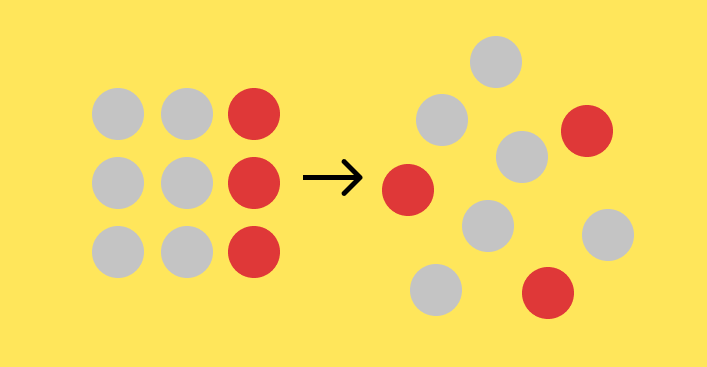Have you ever wondered why your home needs tidying up from time to time? For some reason, socks always end up on the floor, your desk is a mess and that one thing you need is buried somewhere in the closet. Objects just take the most random places in the house for no apparent reason.
There’s a simple explanation for this – probability. When certain items have one and only one “correct” place and a million “incorrect” places, the probability of an object occupying an incorrect place is much larger. Of course, if you apply energy to the system (tidying up), then things are set back to order.
The same thing happens at work. We don’t always send the right email at the right time. We don’t always give the right call to the right person. We don’t always work on the right tasks. Actually, things get out of order at the office much faster than at home.
To make things worse, add the frequent changes that happen all the time in business. A new project flies in, a few colleagues leave, new ones get added to the team, the boss is replaced. All of that is a certain recipe for chaos.
The Entropy, the Chaos and Murphy's Law
This whole thing is even backed up by theory. The second law of thermodynamics states that the level of entropy in a system can never decrease over time. Because entropy is so important for the rest of the article, let’s dig a bit deeper into it.

Entropy at a glance
Entropy is often explained as the level of randomness in a system. The higher the entropy, the greater the randomness. In other words, the second law of thermodynamics states that each system tries to revert into chaos. And it really will. All you need is a bit of time. This is what stands behind Murphy’s law - “If something can go wrong, it will go wrong”. I’ll just add “give it some time”.

Source: common.wikimedia.org
What the Heck Does Kanban Have to Do with Entropy and Murphy's Law?
You must be wondering how Kanban connects to all that. Let me get to it real quick.
There are only two ways to fight back entropy:
- prevent the dispersion of energy or
- inject additional energy to undo the dispersion
Getting back to our first example, you could either keep your desk in order and never have to clean it up or be messy and tidy it up when you stop seeing your keyboard.
Kanban is probably the best tool to help you with both of these things. Here’s how.
Visualize Chaos
When you visualize your work, you actually visualize the degree of entropy in your system. If boards are neat and tidy then most likely work flows through the system, and everyone is happy. If that’s the case, entropy is low, which means chaos is low. However, if you see piles and piles of work clogging your boards, entropy has taken over, and it’s time to act. If you leave it be, Murphy’s Law will be right around the corner.
The visualization in Kanban is the signal that you have to start picking your socks up from the floor. It puts a mirror in front of you and shouts “TIME FOR LAUNDRY”. That’s when acts of leadership are required. If you find that leadership, you will fix the problem and entropy will go back to its rabbit hole. If not, you will start saying “Kanban didn’t work for us”.
Focus Your Energy by Limiting Work-in-Progress
Once you chase off entropy from your process, you can introduce the second practice of Kanban - limiting work in progress. Technically speaking, you can and should use it in combination with the first practice, so that you get to a stable state faster.
This practice allows you to focus the energy in your system towards a few important goals. It’s like a magnifying glass that you use to start a fire.
As long as you keep the magnifying glass with a very sharp, steady focus, the temperature will grow and the paper will burn. But if you shift it from one place to the other and then to the other, you will not achieve the desired results.
And just so you know, nobody said it was easy. In fact, it’s one of the hardest things you can do in business. Reversing the second law of thermodynamics sounds like a challenge, even if our companies are not exactly thermodynamic systems.
But how do you do that? Well, in order to prevent the force that’s increasing your system’s entropy, you need to continuously apply counter-force. But don’t worry, we won’t get you into Newton’s third law, it’d be too much for a single article.
In reality, applying a counter-force means that Kanban requires someone to “run it”. If a team or an organization is left alone after an initial training or coaching session, it is most likely going to revert into its previous, less-ordered state. Unfortunately, this is a mistake we see all the time. That’s why we prefer working with partners who are closer to the customers and are able to guide them along their Lean/Agile journey.
The only successful model for implementing Kanban and Lean, in general, is the Mentor-Mentee relationship between senior staff and the upcoming generation of leaders. If you manage to reprogram your company’s DNA in such a way that continuous improvement is as usual as breathing, the amount of energy required to keep entropy low is going to decrease over time. Then, one day, no additional energy is going to be required or at least it’s going to be a very small amount.
Then, your company will be in the state of “thermodynamic equilibrium”, where entropy has reached its maximum. The difference between you and the competition is going to be that your maximum is radically lower than theirs. In other words, you’ll have negated Murphy’s law.

Dimitar Karaivanov
CEO and Co-founder of Businessmap
Dimitar is a lean thinker and a Kanban practitioner with a solid background in the areas of software development and process improvement. He is passionate about achieving extreme performance at scale and applying Lean/Agile principles outside IT.



